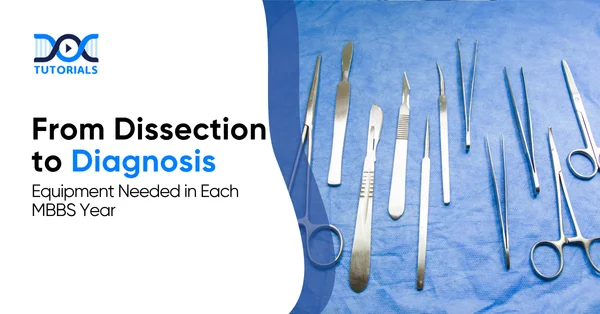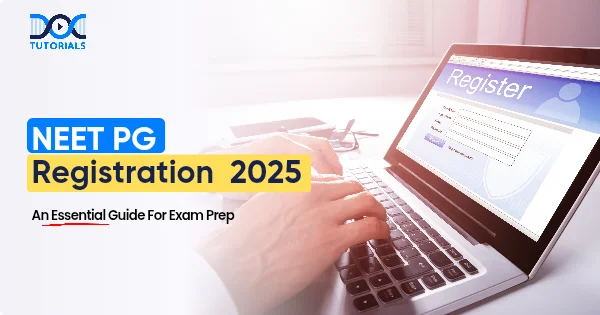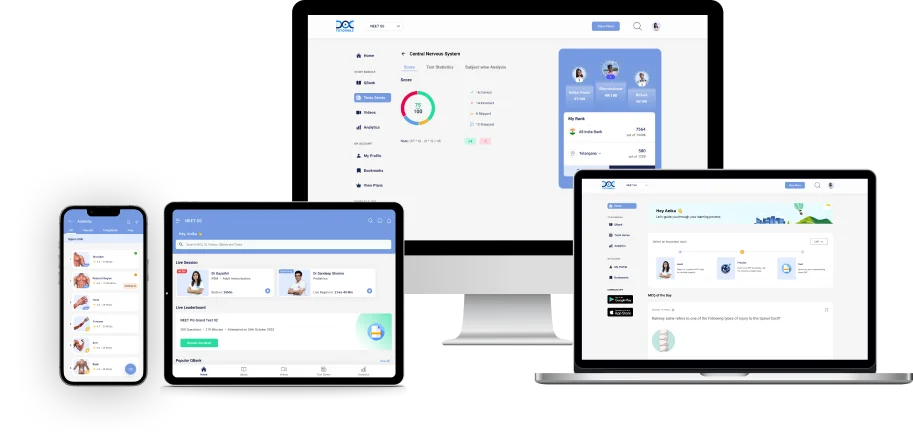From Dissection to Diagnosis: Equipment Needed in Each MBBS Year

When you become eligible for NEET UG and initiate your MBBS life, a new step in the medical learning process begins: when you have already learnt about the functioning of the human body, but now there are people, patients in real-life situations, on your table. Every MBBS year has its own distinctive subjects, and so it has its own instruments and laboratory equipment necessary for practical training.
As a new medical student, you need to know what equipment you will be working with at each phase, which will keep you prepared and confident.
This guide provides a year-by-year breakdown of invaluable MBBS tools, ranging from dissection tools in first-year anatomy classes to diagnostic and clinical equipment in final-year clinical rotations and internships.
Year 1 (Preclinical): Anatomy, Physiology & Biochemistry
- Anatomy Lab
The first year focuses on gross anatomy and, therefore, restricts the dissection rooms to special equipment. Students are usually expected to have a dissection kit including scalpels, scissors, bone saws, forceps, and probes capable of working on cadavers. Dissection tables (usually of marble) and cadaver storage tanks are also found in anatomy departments.
For example, an anatomy department of a medical college includes the following equipment in the list:
- Tables with a stainless-steel top
- Electric bone saws
- Brain knives
- Skeleton cabinets
- Plastic jars
- Specimen tanks
All first-year students have to wear gloves and a lab coat (apron) in dissection.
- Skeleton Models and Bone Sets
An entire model of boneset or skeleton is used to study osteology. There are a lot of students who purchase a plastic set of bones to have a reference over the year. (Veteran students often sell theirs to juniors after the course.)
- Anatomy Charts and Models
Colour charts of nerves, muscles and organs and 3D models of the anatomy supplement the cadaver study. The anatomy museum normally contains several skeletons, jars with dissected specimens, and organ models.
- Histology Lab (Microscopy)
Anatomy deals with human histology (tissues). Students use microscopes (monocular and binocular microscopes) and prepared slides. The anatomy departments generally include 130 monocular microscopes and 14 trinocular microscopes with digital cameras for student use.
Colleges provide basic histology laboratory equipment: microtomes used to slice sections, slide cases, and staining reagents. To hand-draw the tissue diagrams correctly, students usually carry histology colour pencils.
2. Physiology Lab
The practicals in physiology explain the functioning of the body. Different important clinical tools are presented. Each student will work with the stethoscope and sphygmomanometer (BP cuff). The first-year practice lab in physiology usually has:
- Basic Examination Tools
Reflex hammer (to examine tendon reflexes), tuning forks (to examine sound/conduction tests), clinical thermometers, and a pen torch to examine pupil response. They are commonly personal tools that students purchase.
- Lab Apparatus
Physiology laboratories in colleges usually have equipment such as spirometers (to measure lung capacity), ergometers or treadmills, BMR calculating apparatus (calorimeters), and kymographs (for recording experiments).
- Electronic Simulators
Most colleges use digital monitors (pulse oximeters, ECG simulators) in order to measure heart rate, lung capacity, etc. Students are trained on how to utilise sphygmomanometers and routinely measure vital signs in physiology.
3. Biochemistry Lab
The biochemistry lab also employs important equipment, even though it focuses more on chemical processes. Some frequently used instruments are:
- Centrifuges (blood/urine assays)
- Spectrophotometers (enzyme assays)
- Biochemistry analysers
- pH meters
- Warm/hot/cold water baths
- Micro-pipettes may be used in case of accurate liquid work (a set of 0.1–1000 μL pipettes covers most needs)
In summary, first-year learners must be prepared with:
| Category | Essential Items |
| Protective Gear | Sturdy lab coat/apron, safety gloves |
| Dissection Tools | Personal dissection kit (scalpels, forceps, scissors, probes, etc.) |
| Study Materials | Lab notebook, colour pencils for diagrams |
| Osteology | Bone set or skeleton model |
| Physiology Tools | Stethoscope, sphygmomanometer |
| Basic Personal Tools | Thermometer, reflex hammer, penlight/pen-torch |
The college supplies all the larger instruments (dissection tables, cadavers, microscopes, centrifuges, and distillation units). Figuring out how to use them (with faculty guidance) is part of early medical training.
Year 2 (Paraclinical): Pathology, Microbiology & Pharmacology
The second year changes to disease mechanisms. Students require additional laboratory and clinical equipment:
- Pathology
This branch consists of two components: general pathology (cells, tissues) and histopathology, and demonstrations at autopsy. Critical equipment is:
- Microscopes
Just like in histology, dozens of compound microscopes are available in pathology labs to examine the slide.
- Histopathology Tools
Microtomes, tissue sections, tissue processors, embedding stations, and slide staining kits (for H&E, special stains).
- Autopsy Suite
Pathology usually manages the mortuary within hospitals/medical colleges. They include tools like a bone saw (oscillating saws), rib shears, skull chopper, Gluck cranial perforator, and heavy-duty forceps. Medical students usually only observe autopsies, but knowing the names of these tools is key.
- Specimen Preservation
Formalin vehicles, mortuary freezers/coolers (cadaver refrigerators), and plenty of specimen jars are required.
- Grossing Table
A good, lighted, large metal desk on which specimens are inspected.
- Microbiology
Lab work is paramount here. Equipment includes:
- Autoclave: Sterilise growth media and glassware.
- Incubators: In the case of bacterial/fungal culture plates. (maintaining 37°C, 25°C, etc.).
- Biosafety Cabinet (laminar flow hood): To work with pathogens securely.
- Culture Media & Kits: Bottles of blood culture, agar plates, biochemical test kits (identification trays).
- Microscopes: Phase-contrast microscopes or simple light microscopes for smears (Gram stain, acid-fast).
- Gram Staining Setup: Staining racks, chemicals, and distilled water.
- Rapid Test Kits: Based on the college, malaria, HIV, HCG, and other kits can be demonstrated.
- Pharmacology
At this point, it is all about drug effects (primarily animal-based laboratories). Important equipment includes:
- Kymograph: A vintage yet traditional drum recorder that was employed in the experiments of muscle and nerve response.
- Organ Bath Systems: Often, a Rudolph Magnus organ bath is used for observing drug effects on isolated tissues.
- Analgesiometer (Tail-flick, Hot-plate): To determine the pain response of lab animals.
- Rotarod Apparatus: In the case of motor activity in animals.
- Electroconvulsivator: To induce seizures pharmacologically.
- Analytical Balance and pH Meter: For preparing solutions.
- Spectrophotometer: For drug assay (e.g., UV-270 spectrometer listed)
- Dissolution Testers: To determine the drug release of tablets.
- Virtual/Computer Simulators: With the new Competency-Based Medical Education (CBME) curriculum, there are also cases where a simulator is used in place of live animals in some colleges.
The department supplies students with these large machines, as they rarely buy them independently. But it is essential in exams to know the names and functions of equipment (such as a spectrophotometer or organ bath).
Year 3 (Clinical Pre-final): (Forensic Medicine, Community Medicine, ENT & Ophthalmology)
During the third year, the MBBS curriculum typically includes ophthalmology, ENT (ear-nose-throat), community medicine, and forensic medicine, as well as running hospital rounds. The equipment is more specialised:
- Forensic Medicine
This is a subject that intersects pathology with regard to legal cases. Equipment includes:
- Anthropometry Kit: Measuring tape, callipers (width/length of skull), height scale.
- Dactylography Kit: Fingerprinting set – stamp pad, brushes, powders.
- Toxicology Lab Glassware: Blood collection kits, reagents, and containers.
- Morgue Gear: The same as pathology (bonesaw, scalpel, etc.), as medicolegal autopsies are performed here.
- Photography Equipment: For documenting wounds (not a personal item, but a tool students must see in action).
Precise lists are difficult to locate on the Web. Still, forensic classes focus on the understanding of the autopsy tools and the autopsy procedure, so you will use your experience with morgue tables and sharp dissection tools (as per the list at the anatomy department) to your advantage.
- Community Medicine (Preventive & Social)
Fieldwork is the highlight; hence, the equipment is a combination of medical equipment and survey gadgets. Common items include:
- Basic Clinical Tools: Another sphygmomanometer and stethoscope (students often already have from Year 1).
- Anthropometric Tools: Weighing scale, adult stadiometer, infantometer (baby length board, etc.), and non-stretch measuring tape of MUAC (mid-upper arm circumference).
- Diagnostic Kits: Glucometer and strips, haemoglobinometer (or HemoCue), blood group slide kit (for teaching transfusion), and sterile syringes.
- Rapid Test & First-aid Kits: Kits for malaria rapid testing, HIV screening, tuberculin tests, etc., along with a well-stocked first-aid kit for camps.
- Vaccination Kit: Cold box or vaccine carrier with thermometers and sterile needles/syringes for immunisation programmes.
- Public Health Tools: Iodine testing kit for salt, water testing kits, insect nets, or mosquito catching kits.
- Safety and Survey Gear: PPE (gloves, masks), earplugs (for noise exposure studies), and sometimes a simple ECG or portable X-ray for demonstration.
- Laboratory/Equipment Room: Community medicine departments might even stock a clinical thermometer (e.g. Clinical Thermometer -10), stadiometers, and other equipment with which students can practise.
- Ophthalmology
The ophthalmology department has an array of instruments:
- Ophthalmoscope and Retinoscope: Portable devices to examine the retina and refractive status. Most students purchase a pocket ophthalmoscope for training.
- Vision Charts: Snellen’s chart (for acuity) and Ishihara plates (colour vision) are available.
- Slit Lamp: A tabletop microscope with a bright light to examine the eye. (usually used by faculty, but students observe its use)
- Tonometer: For measuring intraocular pressure (air-puff or Goldman).
- Trial Lenses and Phoropter: For refraction tests (used in clinics).
- Other Tools: Pin-hole (card), eyelid speculum, conjunctival swabs, and occasionally Schirmer’s strips for dry eye.
- ENT (Oto-Rhino-Laryngology)
Common instruments include:
- Otoscope: A head-mounted or pocket device to inspect the ear canal and drum. Many students carry a basic otoscope.
- Head Mirror/Light: Classic reflective mirror for directing light into ears/nose, though many clinics now use headlamps.
- Tuning Forks (512 Hz, 128 Hz): To perform Weber and Rinne tests for hearing.
- Nasal Speculum and Throat Forceps: For nose and throat examination. Tongue depressors and laryngeal mirrors (for the throat).
- Audiometer: Screening hearing test machines (often in ENT clinics, not personal equipment).
- Microscopes: Operative microscopes for ear surgery (students need only see these in use).
- General Clinical Tools (Medicine/Surgery Glimpses)
By Year 3, students also start general medicine and surgery postings:
- Stethoscope and BP Apparatus: Continually used on wards.
- Thermometer, Pulse Oximeter: For vital signs monitoring.
- Ophthalmoscope/Otoscope: These are often not personal, but students practise with them.
- ECG Machine: Wards have ECG consoles (cardio leads and paper).
- Bedside Ultrasound: Portable ultrasound is increasingly common even on ward rounds.
- Nebulisers and Spirometry: For pulmonology assessments in medicine.
- Surgical Basics: Scalpels, retractors, sutures, and plaster saws are also provided in trays during surgery rounds (they are part of the hospital, but none are included in a student’s kit). It is essential to know their names and applications.
Years 4 (Clinical & Final): Advanced Diagnostics & Hospital Training
The last two years (including internship) deal with major clinical specialities – General Medicine, General Surgery, Obstetrics, Paediatrics (continued), Orthopaedics, Psychiatry, Dermatology, etc., requiring advanced instruments. Here is a detailed overview:
- Obstetrics & Gynaecology (OBG)
Equipment revolves around antenatal care and delivery:
- Vaginal Specula (Cusco’s, Sims): Metal or plastic instruments to visualise the cervix. Every OBG exam room has several sizes of equipment.
- Fetoscope (Pinard) or Doppler: A wooden cone or Doppler device to listen to foetal heart tones. Many students use foetoscopes in rural postings.
- Ultrasound: High-resolution obstetric ultrasound machines are now widely available. (Students learn the basics but do not perform scans themselves.)
- Exam Bed and Stirrups: A gynaecological examination chair with leg supports.
- Forceps and Vacuum Extractors: Tools for assisted vaginal deliveries (mostly used by seniors).
- Suture Sets & Episiotomy Scissors: For deliveries, students observe or help in suturing perineal tears.
- Resuscitation Kits: For newborns (neonatal ambu bag, suction catheters).
- Partograph/Monitoring: Charts and dopplers to monitor labour.
- Paediatrics
Child health requires scaled-down tools:
- Paediatric Stethoscope: With a smaller chest piece for infants.
- Infantometer: A baby-length measuring board (see Community Med list).
- Paediatric Scale: Cradle or digital scale for infants (mass measurement).
- Vaccination Supplies: Infant vaccine carrier and syringes (similar to Community kits).
- Neonatal Equipment: Incubator (for premature babies), CPAP machines, and infant warmers (usually in NICU).
- Paediatric Emergency Kit: Devices like pediatric masks, IV cannulas, paediatric defibrillator pads, etc.
- Growth Charts and Development Kits: For tracking height/weight and developmental milestones.
- General Medicine
Premium monitors and machines are involved, including:
- ECG monitors, pulse oximeters, and defibrillators are observed in wards by the students.
- In referral hospitals, advanced diagnostics such as 2D Echocardiograms, Holter monitors, Spirometer (Pulmonary Function Test unit), and EEG/EMG machines are used.
- The intern learns to order ECGs, interpret chest x-rays, and lab reports.
- General Surgery
- Some of the tools used in operating theatres include laparoscopes, endoscopes, C-arms, electrocautery, and anaesthesia machines.
- A surgery kit would contain scalpels, retractors, forceps, needle holders and sutures.
- Students help in surgery and get to recognise various tools such as Babcock clamps and sponge-holding forceps.
- Surgeons and students always put on sterile gloves, gowns, and drapes.
- In wards, staff manage chest drains, monitors, and portable X-rays that students observe.
- Obstetrics (Final)
- Later in obstetric training, students learn about ultrasound machines, foetal monitors (cardiotocography), and delivery kits (complete sterility sets for caesarean sections).
- In delivery rooms, there is neonatal resuscitation equipment (ambu bags, oxygen masks, and infant CPR mannequins).
- Orthopaedics
The equipment used is as follows:
- Bone imaging equipment (fluoroscopy/ C-arm)
- Casting equipment
- Traction equipment
- Ortho wards and theatres have power drills, fracture tables, and kits of skeletal traction.
- Ophthalmology/ENT (Advanced)
At higher levels of ophthalmology rotation, students may observe ear surgery, keratometry, slit-lamp biomicroscopes or tonometry equipment.
- Radiology
Although not directly applied to MBBS students, clinical training involves communication with imaging modalities. There are X-ray machines, ultrasound machines, and CT/MRI (managed usually by the radiology department, but interns study indications).
- Emergency & ICU
The most important items are advanced life support equipment. Routinely used in ICUs/ERs are:
- Defibrillators
- Ventilators
- Infusion pumps
- Central line kits
- Crash carts (with emergency drugs)
- MBBS interns are also taught the fundamentals of using intubation equipment (laryngoscope blades, endotracheal tubes) and CPR mannequins.
During Years 4 and 5, students seldom purchase new personal devices other than a laptop or tablet to do their studies. They still wear their stethoscope, reflex hammers, ophthalmoscopes (if not provided), and surgical scrubs.
Technology is mostly institution-provided. The emphasis is placed not on purchasing the instruments but on learning clinical proficiency in them under supervision.
Key Advanced Equipment (examples)
- Ventilator
- Pulse oximeter
- Cardiac monitor
- Syringe pump
- Ultrasound machine
- Bronchoscope
- Laparoscope
- ECG/EEG machines
- Foetal doppler
- Anaesthesia machine
- Operating microscope
- Defibrillator, etc.
These technological tools are essential for final-year study and work experience, even though they are technically included in postgraduate/department inventories.
Internship (Practical Application)
Diagnosis is an experience that may be entirely realised during the 1-year rotating internship. With little supervision, intern work involves assisting a patient with all the equipment they have been trained on (and some they have not). Vital equipment in an internship entails:
- Basic Kits: All the interns have a stethoscope and usually an internship kit bag containing a reflex hammer, BP cuff, NIBP monitor, penlight, gloves, and scissors. They can invest in an efficient sphygmomanometer (digital or Aneroid).
- Emergency Gear: Interns in casualty/emergency see the use of airway management kits (laryngoscope with Macintosh/Miller blades, bougie, endotracheal tubes, and AMBU bags), ECG machines, defibrillators, IV fluids and intravenous sets, central venous catheter kits, etc.
- Surgical Tools: At the end of the rotations, interns are skilled in working with surgical sets – they can suture, place IV lines, and help with minor work (e.g., abscess drainage, Foley catheter insertion). They have their own sterile gloves and masks, but hospitals also provide gloves.
- Laboratory Sampling: Interns draw blood using phlebotomy needles and vacutainers, and they know how to operate point-of-care devices (glucometers, rapid kits, and arterial blood gas analysers).
- Resuscitation and Monitoring: They often use defibrillators, oxygen tanks/regulators, suction machines, and continuous monitors (oxygen saturation, ECG, etc.). Knowledge of these machines is expected.
- Speciality Equipment: In rotations like cardiology or anaesthesiology, interns might learn to perform ECGs, intubations with a video laryngoscope, and operate ultrasound machines (for line placement, FAST scans, etc.).
- Continued Use of all Earlier Tools: The basic instruments of the first year will still be important, the same stethoscope, ophthalmoscope and so on. Vitals paper, calculators (to compute the dosage of a medicine), and hospital computers are also used during the rounds of medicine and surgery, where interns access electronic records.
Interns do not commonly purchase major equipment; however, they usually purchase quality personal items, such as a sturdy stethoscope (like a Littmann), a penlight, and an ophthalmoscope, in case they are required.
At this point, expertise with all instruments is presupposed; it depends on how competently one can apply it to arrive at a diagnosis, hence, from dissection to diagnosis.
FAQs About Equipment Needed in Each MBBS Year
- How should I sterilise and maintain my instruments to pass practicals and exams?
Clean instruments with a little detergent and then sterilise with an autoclave (121°C for 15–20 minutes) or chemical sterilants such as glutaraldehyde. Place them in well-sealed containers to stop rust. Have them sharp, greased, and clean during exams.
- Do I need to buy a dissection kit before joining MBBS, or can I wait?
Not immediately. Wait till your professors or seniors tell you what is required when dissecting for the first time. You need to purchase the simplest instruments: a scalpel, scissors, a probe, and forceps. Currently, it is sufficient to have a starter kit.
- What are the most common mistakes students make while buying MBBS equipment?
Purchasing tools with rusty, weathered, or incorrect sizes. Missing step-by-step advice from seniors and forgetting storage cases are widespread issues. Always use medical-grade stainless steel and verify whether tools are autoclave safe.
- Do government medical colleges provide any instruments, or do students buy everything?
They offer common laboratory equipment, microscopes, and cadavers. However, practicals and clinical examinations require students to purchase personal equipment, such as dissection sets, stethoscopes, and lab coats.
Conclusion
MBBS education is more than books; it is a field of learning to use medical apparatus and patient care. Starting with scalpels and microscopes, growing with diagnostic instruments and surgical tools, and so on, one gains confidence with every step. At colleges, students receive all the major equipment, but basic items like a stethoscope, a BP kit, and a lab coat are required. With regular practice, using these tools becomes a life-saving skill.
Train on how to use each tool correctly, maintain it properly, and always adhere to safety and hygiene measures. With proper equipment and training, you’ll smoothly progress from dissecting in the lab to diagnosing real patients with confidence.
If you’re looking for structured guidance during your MBBS journey, DocTutorials can help. Our comprehensive MBBS curriculum offers full syllabus coverage, expert mentorship, end-to-end exam support, and complimentary hardcopy notes.
Join DocTutorials and take the next step toward becoming a successful medical professional!
Latest Blogs
-

INI CET Exam Pattern 2025: A Complete Guide with Subject-Wise Weightage
The Institute of National Importance Combined Entrance Test (INI CET) is your key to entering some of the most prestigious…
-

NEET PG Registration 2025: An Essential Guide For Exam Prep
The NEET PG registration, which is conducted online, is a crucial step in the exam process. Filling out the NEET…
-

NEET PG Syllabus 2026: A Must-Have Complete Guide for Exam Success
The NEET PG Syllabus acts as one of the foundation stones for aspiring postgraduate medical students like you who are…




